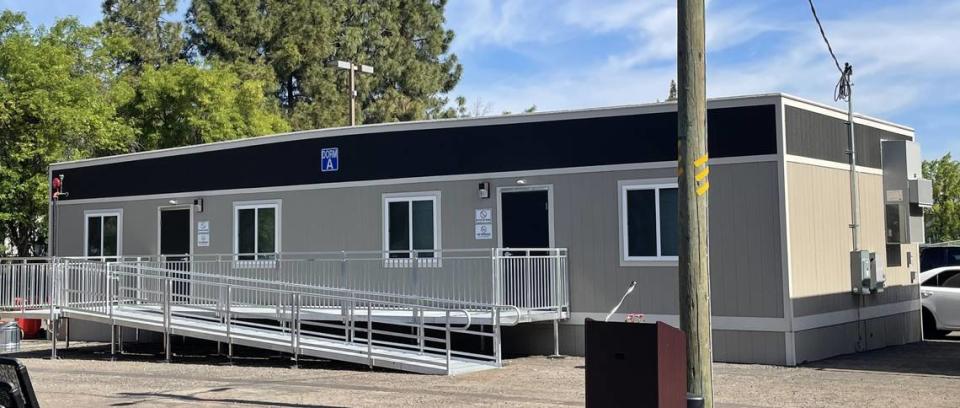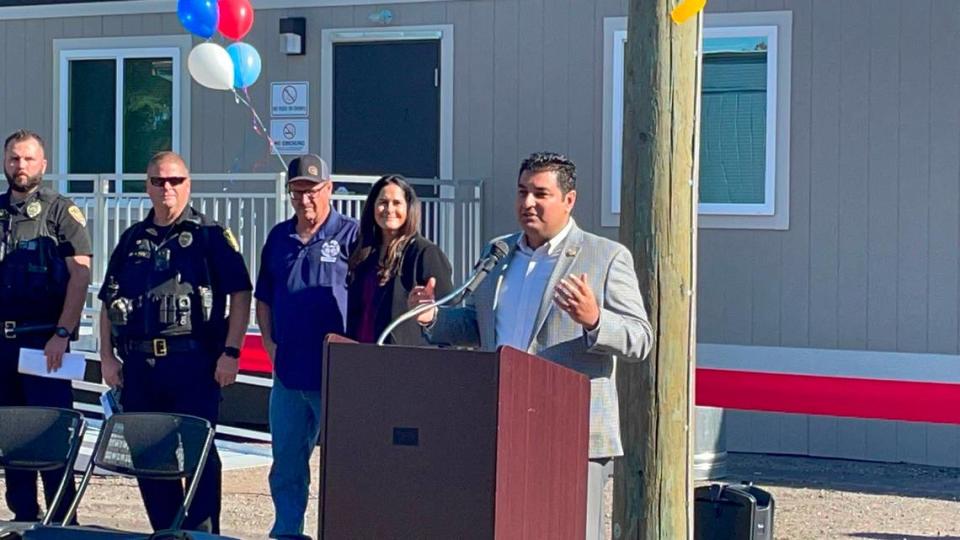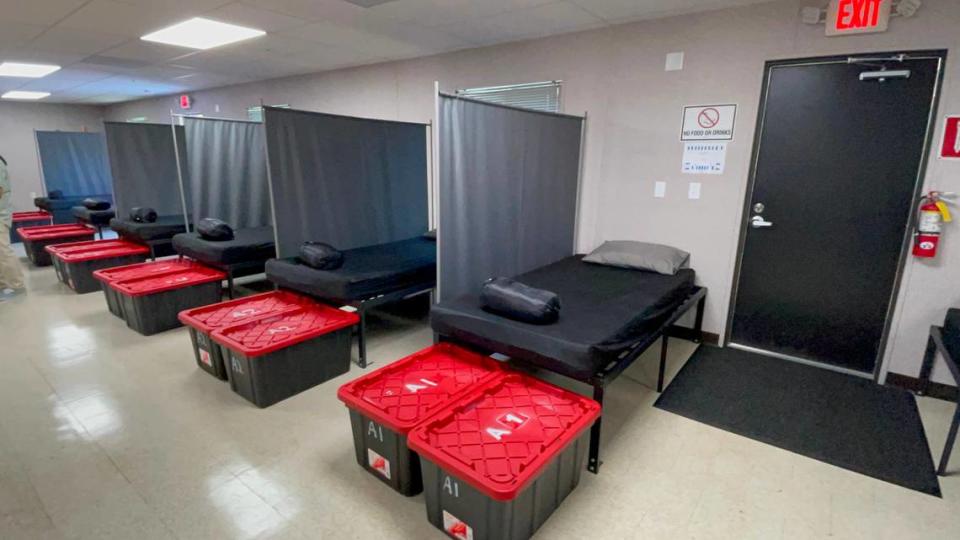Manteca debuts homeless dorms. Site also could get 192 affordable apartments near ACE depot
Eight vacant acres just south of downtown Manteca are key to the city’s efforts on homelessness.
It has secured about $20 million to provide 283 dorm beds in several modular buildings, along with space for social services.
Manteca also seeks funding for 192 affordable apartments on the city-owned parcel’s west side, as tall as four stories. Grocery stores and a planned rail depot are a short walk away on South Main Street.
Project partners gathered April 16 to celebrate the first phase: 50 beds in new men’s and women’s dorms. They are located for now on a separate property along Industrial Park Drive, where homeless people have pitched ragtag tents in recent years. The modular units will be trucked about a quarter-mile west to the permanent site once utility lines are in place.
Susan Martinez, 62, is moving into the women’s dorm. She said she lost her job at the nearby Walmart and mostly lived in her car during about a year of homelessness. She was briefly a tent camp occupant.
“This is a great steppingstone for the people who want to get out and get a job, and that’s my main focus and my goal,” Martinez said. “... You don’t want to be out there staying in the car. It’s really hard.”
The temporary site is operated by the nonprofit His Way Refuge Center, founded in 1998 by pastor Al Deardoff. Clients can eat three meals a day, take showers, do laundry and get help with job searches and sobriety.

Manteca apartments average $2,087 a month
The Modesto Bee ventured north for the event to supplement its coverage of Stanislaus County’s housing shortage. It found an even tougher market.
Manteca’s average monthly rent was $2,087 in the last quarter of 2023, compared with $1,659 in Modesto, according to rentcafe.com.
In the same quarter, only 22% of San Joaquin County households could afford to buy the median-priced home, at $546,100, the California Association of Realtors reported. In Stanislaus, the price was $465,000 and only 23% of families could swing it.
The Manteca dorms are funded mainly by $16 million from the California Department of Housing and Community Development. An additional $2 million came from the county government and about $1.5 million from other state and federal sources. The city provided almost $900,000.
Manteca Mayor Gary Singh told the crowd that the project emerged after a federal court in Idaho limited anti-camping laws in cities. That case is now before the U.S. Supreme Court.
Singh said the dorms mesh with the Manteca Police Department’s effort to connect homeless people with various services. Officers work with county and nonprofit providers on this, similar to agencies in Stanislaus.

Mayor urges compassion for homeless
Singh said his fellow City Council members “understood that we have to take care of our own. We cannot just turn a blind eye, hoping that the homeless or the unsheltered will just go away.”
The dorms will be part of a “navigation center” on the east side of the eight acres, where residents can get help with physical and mental health and other needs.
The council plans to call for bids in June from contractors to install the modular buildings as they are purchased, City Manager Toni Lundgren said. Work would start later this year.
At build-out, the site will have 154 dorm beds for men, 93 for women and 36 for families with children. The center also will feature 16 transitional housing units, a step between dorms and conventional homes.
Residents will enter and exit the navigation center on the east, a mostly industrial zone. A tall masonry wall will screen it from the future apartments on South Main.

‘I’m on board,’ one resident says
The two dorms showed off April 16 have 25 cots each, with privacy screens. Residents can stow belongings in plastic crates next to their beds.
The dorms have their own heating and cooling, but restrooms and showers are in other modular buildings. The site also has a large kitchen.
Residents will not pay rent, but they must follow rules against illegal drugs, noise and the like. Their pets can sleep in kennels on the site.
Martinez talked with The Bee about her new home after officials cut a ribbon and toured the two dorms. “I’m on board, I’m happy, and I’m very grateful for this opportunity,” she said.
The first two dorms are not for children. They can instead stay at the nonprofit Hope Family Shelter on Union Road, which also serves women, Lundgren said.
Few details yet on 192 planned apartments
The city does not yet have a cost estimate or timeline for the 192 apartments along South Main. It also has not determined the rents or how residents would be chosen. Both private and public funding will be sought.
The apartments are designed to encourage walking and transit use, both cheaper than driving. Walmart and Safeway are about two blocks to the south, along with several smaller stores.
The complex would have new businesses on the ground floor and up to three stories of housing above. They plan includes 72 studio apartments, 72 one-bedroom units and 48 with two-bedrooms.
The Manteca Transit Center is about a quarter-mile north of the apartment site. It is the hub for city buses now. As soon as 2026, it will also serve Altamont Corridor Express passenger trains.
ACE now runs on weekdays between Stockton and San Jose, timed for commuters to Bay Area jobs. The expansion will bring several stations between 2026 and 2030 on one branch to Merced and another to Sacramento.


